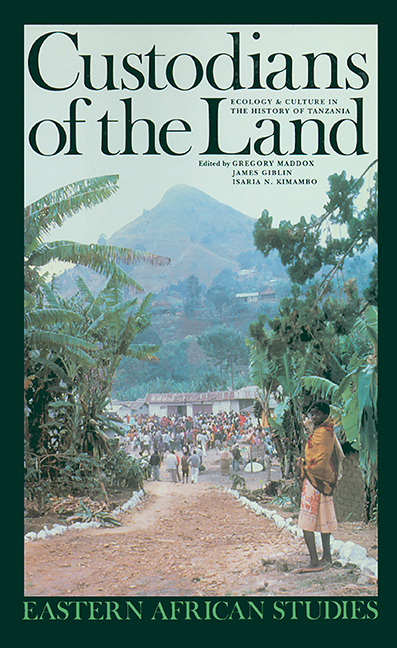Book contents
- Frontmatter
- Contents
- List of Maps, Figures & Tables
- List of Photographs
- Abbreviations
- Contributors
- Acknowledgements
- Introduction Custodians of the Land: Ecology & Culture in the History of Tanzania
- Part One Environmental & Demographic Change
- Part Two Environmental Change & Economic History: In Tanzania's Northern Highlands
- Part Three Politics & Environmental Change
- Part Four Environment & Morality
- Seven Environment, Community & History: ‘Nature in the Mind’ In Nineteenth- and Early Twentieth-Century Buha, Western Tanzania
- Eight Canoe-Building Under Colonialism: Forestry & Food Policies in the Inner Kilombero Valley 1920-40
- Nine Struggles for the Land: The Political & Moral Economies of Land on Mount meru
- Conclusion
- Bibliography
- Index
Eight - Canoe-Building Under Colonialism: Forestry & Food Policies in the Inner Kilombero Valley 1920-40
from Part Four - Environment & Morality
Published online by Cambridge University Press: 30 August 2017
- Frontmatter
- Contents
- List of Maps, Figures & Tables
- List of Photographs
- Abbreviations
- Contributors
- Acknowledgements
- Introduction Custodians of the Land: Ecology & Culture in the History of Tanzania
- Part One Environmental & Demographic Change
- Part Two Environmental Change & Economic History: In Tanzania's Northern Highlands
- Part Three Politics & Environmental Change
- Part Four Environment & Morality
- Seven Environment, Community & History: ‘Nature in the Mind’ In Nineteenth- and Early Twentieth-Century Buha, Western Tanzania
- Eight Canoe-Building Under Colonialism: Forestry & Food Policies in the Inner Kilombero Valley 1920-40
- Nine Struggles for the Land: The Political & Moral Economies of Land on Mount meru
- Conclusion
- Bibliography
- Index
Summary
In early November 1937, a team of forestry officials toured the wooded slopes of the eastern Uzungwa escarpment in southern Tanzania. In a small clearing in the heart of the Matundu forest, they came upon what they had been looking for: a small group of men engaged in hollowing out large trunks of the mwawa tree ﹛Khaya nyasica, a mahogany) for canoes. The foresters found seventeen finished mwawa canoes and several others in various stages of completion. The canoes ranged from 33 to 58 feet in length, and from 7 to 10 feet in girth. A canoe of this size was capable of carrying a load of rice weighing 3 tons, with a crew of six to eight men.
The foresters were alarmed by what they saw. They decried the 'wasteful destruction’ of valuable hardwood timber by the Africans, declaring the need to ‘instil in the native mind that this timber is valuable and the supplies not inexhaustible'. All of the downed trees had been felled within ten minutes’ walking distance of the canoe site, and one of the canoes had been abandoned half-finished, left to rot and 'riddled with borer'. In the eyes of the foresters, the great size of the canoes represented an ignorant and wanton attack on old-growth timber. They doubted whether the average fisherman required ‘a forty foot canoe for fishing, visiting his friends, and in the course of his everyday life’.
The forestry department had found the evidence it needed to implement stricter regulation of African access to forest resources. Although each of the canoe-builders possessed a legal permit to fell trees and was therefore within the limits of existing law, the foresters saw the Matundu case as proof that district forestry legislation was too weak, for it allowed excessive exploitation of valuable species. The foresters successfully argued their case for stronger legislation at the district and provincial levels in terms of use rights to individual tree species. Limitations on what constituted ‘proper’ or ‘economic’ usage, imposition of fines and royalties, and the demarcation of forest reserves were all used to restrict tree cutting by local peoples.
The encounter in the Matundu Forest between the canoe builders and the forestry officials represents in microcosm a process which was going on throughout forested areas of Tanganyika, indeed throughout colonial eastern and southern Africa, during the 1920s and 1930s.
- Type
- Chapter
- Information
- Custodians of the LandEcology and Culture in the History of Tanzania, pp. 200 - 212Publisher: Boydell & BrewerPrint publication year: 1996

